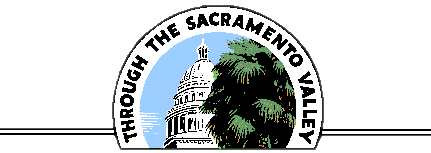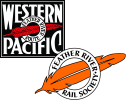THE TALE OF HALL SCOTT MOTOR 1020
with assistance from Peter Hinckley
Hall Scott trailer coach 1020 may be one of the most under appreciated survivors of the Sacramento Northern fleet. This beautiful car is one of the true treasures of the Western Railway Museum, but is often overshadowed by better known rolling stock in their collection.
Coach 1020 was one of eight identical steel trailers owned by the Oakland, Antioch & Eastern. They were built by the Hall Scott Motor Car Company of Berkeley in 1913 and numbered 1019-1026. Hall Scott, perhaps best known for their marine engines, also built a number of self-powered railcars in the early years of the 20th century. The OA&E cars followed Hall Scott's standard gas-electric construction techniques. The cars were 59 feet long, 10 feet-4 inches wide, and originally weighed 61,000 pounds. They seated 60 passengers. The cars rode on Baldwin 79-30B trucks. They were fitted with Westinghouse 15A2 controls in both ends, plus pilots and headlights, allowing them to serve as lead units on self-powered trains. Each car cost the railroad $5,026.

their Berkeley factory in 1913. Peter Hinckley used this photo
as a guide for laying out the restored lettering on 1020.
Peter Hinckley collection.
The OA&E first used the steel coaches in through passenger service between Oakland's Key System pier and Sacramento. The original plan was to pull these cars with locomotives 105 and 106. It was soon noticed that the big motors were shaking the pier to pieces, so in 1915 locomotive-hauled passenger trains were discontinued. Three Hall Scott trailers, 1019, 1020 and 1026 (later renumbered 1018), were equipped with 322E motors, U.S. 14 trolley pole bases, Miller harps and shoes on the poles, U.S. 122D pantographs, and other gear needed to turn them into powered coaches. Their weight jumped to 101,780 pounds.
All of the Hall Scotts had long and successful, if unremarkable, careers for the OA&E and the SN. They were sturdy cars, but were not popular with the crewmen, especially in hot weather. Lacking a clerestory, they could be like ovens. Even the powered cars seldom saw service at the head of a train, unless there was no way to turn the cars for the return trip. One frequently led eastbound on the Concord local, a push-pull operation, as there was no wye at Concord. After the merger the Hall Scotts saw considerable service all the way to Chico, and were common on through trains like The Comet and The Meteor. At least one car even saw service on the Woodland branch.
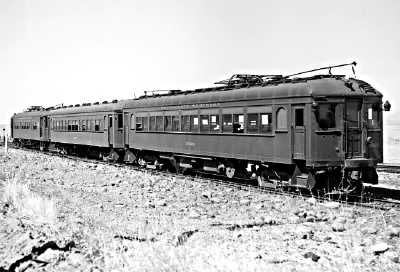
1020 was bringing up the rear of Train #2 at Oroville Junction in
September 1937. The motor is riding on Brill 27-MCB trucks,
the result of another of Mulberry Shops' frequent truck swaps.
1020's original Baldwin 79-30B trucks were later remounted.
Dunk Haft photo; Garth G. Groff collection.
With the end of passenger service in 1941, the Hall Scott cars went on to new careers. Powered coach 1018 ended its days on the Key System as their 499 in 1951. SN 1021-1025 were sold to the Western Pacific as their 451-455. The WP stripped the cars of their electrical gear and used them to carry loggers out of Westwood until four were scrapped in 1951. The last car became an employees lunch room behind the Jeffrey Shops in Sacramento and was not scrapped until about 1972.

their last years as straight coaches. The stack suggests the cars
now had stoves of some sort to keep the loggers snug.
Garth G. Groff collection.
The SN kept two of the powered Hall Scotts, 1019 and 1020, for business, inspection and maintenance duties. During World War II, they were fitted with footboards and saw use as switchers. The motors were renumbered MW 301 and 302 respectively.
MW 301 spent most of its years working out of Chico. With the dieselization of most electrified track on the North End following World War II, the car was no longer needed as a motor. It was stripped of its motors and controls in September 1947 and converted to kitchen car MW 81. This car was purchased by the BAERA in October 1972, and is kept at the Western Railway Museum pending eventual restoration. Enough parts have been stockpiled to restore this car as a powered unit.
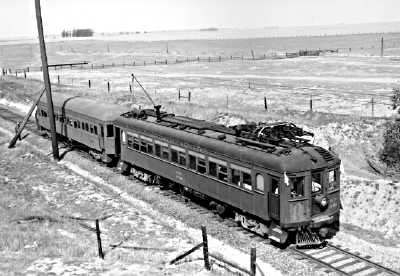
roof shot from the Highway 12 bridge at Rio Vista Junction.
SL&U steel observation 751 is in tow. MW 302 was used on
many excursions until she was damaged by a resistor fire in 1954.
Wilbur C. Whittaker photo; Garth G. Groff collection.
MW 302 fared much better than her sister. This car saw much use on the remaining electrified track between Oakland and Pittsburg into the 1950s. It was fitted up with outside lights and used to inspect the Redwood Tunnel. The car also ran on many excursions, occasionally paired with 1005 or Salt Lake & Garfield observation car 751. Unfortunately MW 302 was damaged by a fire caused when her resistor grids overheated during a 1954 excursion. The car was demotorized in 1955 at the Key System shops in Emeryville and became a lowly bunk car. After SN 1005 was damaged by the WP in 1962, MW 302 was given to the BAERA as compensation. There was some talk at the museum about scrapping 1005 and using her electrical gear to remotorize MW 302, but in the end it was wisely decided to preserve both cars.
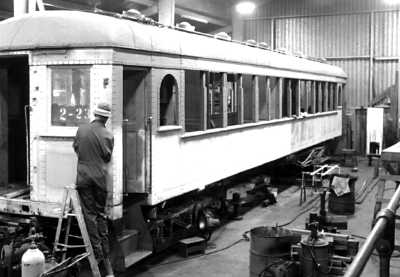
sanded for repainting. The car now wears the original
"Pullman olive green" body, black roof and underbody, and
moss green trucks. The workman on the ladder is Saemus Kilty.
Peter Hinckley photo.
A dedicated group of volunteers have quietly worked since 1972 to restore MW 302 to her original appearance as OA&E coach 1020. In contrast to the big-budget project to rebuild 1005, 1020's restoration has so-far cost less than $30,000. Much of the interior, which had been gutted during the post-war years, has been carefully restored. Most of the seats were missing, but Peter Hinckley salvaged a similar set from the last SP commute car with high-backed seats just before it was scrapped. Recovering the seats with red plush ate up $5,500 of the restoration budget. The mahogany interior was refinished, and hardware such as door handles, seat check holders and luggage racks was restored or replaced with replicas made from new patterns. Some of the interior is actually steel which was originally grained to imitate wood. This took careful restoration, and has fooled many experts. The smoking compartment partition, removed when the OA&E powered the car, has been reconstructed. The outside of the car was stripped and repainted "Pullman olive green", with moss green trucks. Lettering was restored as closely as possible to the original OA&E style.
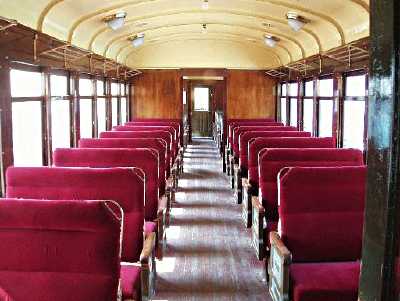
appearance. The red plush seats were used in the general
passenger section. Leather upholstery was used in the
separate smoking section, just as the cars were built in 1913.
Peter Hinckley photo.
OA&E 1020 was in good enough condition to be rolled out for a few runs during the summer of 1999. The car was hauled behind CCT 7 over the museum's former SN track in her first passenger-carrying trip since the 1950s. The impressive restoration work was well received by many enthusiastic riders.
Then 1020 went back into the car barn for more work. Restoration continues on the vestibules and the control cabs. Installation of control wire conduits, junction boxes, controllers, pilots, and a host of other small projects will continue over the next several years. Some of this work will require precious shop time, and must be scheduled around other projects. There is no fixed schedule for completing the car, but hopes are high it will be finished by the time 1005 is again operational. This would allow the museum to run an authentic two-car local train on their restored SN right-of-way.
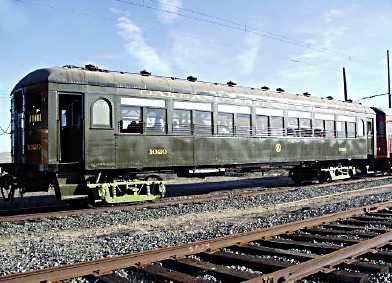
at the Western Railway Museum. The coach was pulled by
Central California Traction Company freight motor number 7.
Bob Battles photo, Peter Hinckley collection
